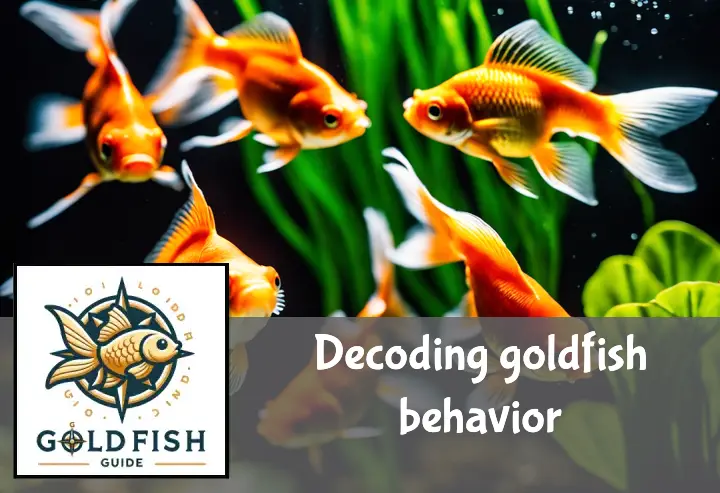Ever caught yourself staring at your pet goldfish, wondering what’s going on in that little fishy brain of theirs? I know I have! It’s fascinating, isn’t it? Well, you’re not alone. Welcome to the world of Decoding Goldfish Behavior.
In this post, we’ll dive deep into the watery world of goldfish and their intriguing behaviors. So put on your snorkeling gear (figuratively, of course) and let’s go exploring! Keep reading about Decoding goldfish behavior. You’re in for a swim-tastic adventure!
Key Takeaways
- Goldfish behavior can be decoded to understand their health and mood.
- Rapid gill movement, erratic swimming, or loss of appetite indicate stress or illness.
- Happy goldfish swim freely, have a good appetite, and show vibrant colors.
- Changes in behavior could also signify the need for a cleaner tank or different diet.
- Interaction with other fish is another key indicator of their wellbeing.
Understanding Goldfish Behavior
Decoding goldfish behavior is like learning a new language. It’s all about understanding fish actions and interpreting the subtle signals they give off. By observing your pet goldfish habits, you can learn to understand their needs and wants better, making your aquarium life more harmonious.
What is Normal Goldfish Behavior?
When it comes to normal goldfish behavior, there are a few things to look out for. First off, their eating habits. Goldfish are known to be little foodies, always on the hunt for a tasty morsel. They’ll eat anything that fits in their mouth – plants, insects, even smaller fish!
Swimming patterns also play a big part in understanding your goldie’s mood. A happy and healthy goldfish will swim around with gusto, exploring every nook and cranny of the tank. If they’re hanging out at the bottom or floating listlessly at the top, something might be amiss.
Lastly, let’s talk about socializing in the fish tank. Goldfish are pretty sociable creatures and love to hang out with their tank mates. They’ll often swim together in groups or pairs, showing off their shiny scales and fancy fins.
How to Observe Goldfish Behavior?
Observing goldfish behavior isn’t as hard as you might think! The key is patience and keen observation skills. Start by watching your fish during different times of day – morning feedings, lazy afternoons, even late-night swims can reveal a lot about their personality.
Next up is environment observation. Keep an eye on how your fish interact with their surroundings – do they love hiding behind plants? Or maybe they prefer open spaces? These clues can help you understand fish body language better.
Finally, don’t forget about aquarium observation techniques! Use tools like magnifying glasses or underwater cameras to get a closer look at your finned friends’ actions. Remember, decoding goldfish signals is all about understanding the small details. So keep observing, and soon you’ll be a pro at interpreting your pet’s behavior!
Common Types of Goldfish Behaviors
When it comes to Decoding Goldfish Behavior, there’s more than meets the eye. From their swimming patterns to eating habits, and social interactions, goldfish exhibit a range of behaviors that can tell us a lot about their health and mood.
Swimming Patterns and What They Mean
Goldfish are known for their unique goldfish swimming styles. A healthy goldfish will swim with a smooth, steady motion. If you notice your fish darting around the tank or floating at the top or bottom, this could indicate stress or illness.
On the other hand, if your goldie is swimming sideways or upside down, this might be a sign of Swim Bladder Disease. So, when it comes to interpreting goldfish swimming, keep an eye out for any abnormal goldfish swim behavior.
Eating Habits of Goldfish
Now let’s talk about grub! The normal feeding routine for goldfish involves small meals throughout the day. But if your fish starts showing changes in its eating habits like refusing food or overeating, it’s time to pay attention.
Overfeeding can lead to constipation and bloating while underfeeding can make them weak. So remember folks, moderation is key! Keep an eye out for signs of overfeeding or underfeeding symptoms in goldfish.
Social Interactions Among Goldfish
Finally, let’s dive into how our finned friends interact with each other socially. Goldies are generally peaceful creatures who enjoy company. However, they do establish pecking orders within their groups.
If you notice one fish chasing others around the tank aggressively or hiding away from the group constantly, these could be signs of stress or bullying among your little swimmers. Understanding these goldfish socializing habits and group dynamics can help ensure your pets’ wellbeing.
Decoding Signs of Stress in Goldfish
When it comes to Decoding Goldfish Behavior, understanding stress signs is crucial. It’s like being a fish whisperer, but instead of whispering, you’re observing and interpreting.
Identifying Stress-Induced Behaviors
Goldfish are pretty expressive if you know what to look for. One key sign of stress-induced behaviors in goldfish is erratic swimming. If your goldie starts darting around the tank like a pinball on steroids, that’s not them having fun – it’s a goldfish distress signal.
Another telltale sign is gasping at the surface. This could mean they’re not getting enough oxygen due to poor water quality or overcrowding. So, if you see your fish panting like a dog on a hot day, don’t ignore it!
Causes of Stress in Goldfish
Now let’s dive into the common reasons for goldfish stress. Environmental factors play a big role here. Imagine living in a cramped apartment with bad air conditioning and noisy neighbors – wouldn’t you be stressed too? Well, that’s how your goldfish feels when their tank conditions aren’t optimal.
Health issues are another major cause of stress in pet fish. Just like us humans, goldfish can get sick and feel under the weather too! So always keep an eye out for any changes in their behavior or appearance – it could be their way of telling you they’re not feeling so great!
Health Indicators Through Behavior
Decoding Goldfish Behavior can be a real eye-opener when it comes to understanding their health. Just like us humans, goldfish also show signs of discomfort or illness through changes in their behavior. So, let’s dive into the world of goldfish health and behavior indicators.
Behavioral Signs of Illness in Goldfish
First off, if your goldie starts acting like a submarine, sinking to the bottom or floating at the top, that’s not normal. This could indicate swim bladder disease. Similarly, if they’re rubbing themselves against objects more than usual, it might mean they’re dealing with parasites or skin issues.
Now, if you notice your fish is less active than usual or not eating properly, these are classic sick goldfish behaviors. It could be due to internal problems or stress. Also, watch out for rapid gill movement – it’s often a sign of respiratory distress.
Changes in Normal Behavior as Health Indicators
On the flip side, sudden changes in normal behavior can also be alarming. For instance, if your usually social goldie becomes withdrawn or aggressive towards tank mates, it might signal stress or illness.
Unusual swimming patterns like darting around the tank erratically can indicate something’s off too. Maybe there’s an issue with water quality or an underlying health problem causing discomfort.
Remember folks! When it comes to aquarium fish behavioral shifts, always trust your gut feeling and consult a vet if needed. After all, our little aquatic friends rely on us for their wellbeing!
How to Influence Positive Behavior in Goldfish
In the world of Decoding Goldfish Behavior, it’s crucial to understand that a conducive environment and proper feeding practices play a significant role. These factors can greatly influence goldfish behavior and promote healthy, positive actions.
Creating a Suitable Environment for Your Goldfish
A suitable environment for goldfish is like their personal zen garden. It can significantly influence their demeanor, making them more lively and interactive. The size of the tank matters – think spacious penthouse, not cramped studio apartment! Quality of water? Crystal clear, please! And temperature? Just right – not too hot, not too cold. All these factors together create an environment that positively influences your goldfish’s behavior.
Feeding Practices That Promote Healthy Behavior
Now let’s talk grub! Correct feeding practices for goldfish are like the secret sauce to promoting healthier behaviors. It’s all about balance – not too much, not too little. The frequency of feeding should be just right (Goldilocks would be proud). And the type of food? Variety is the spice of life! A balanced diet helps keep your goldfish happy, healthy and on their best behavior.
To Wrap Up
In the fun-filled journey of Decoding Goldfish Behavior, we’ve discovered that our finned friends are not just swimming ornaments but curious little water toddlers. They’re social, intelligent, and have a language all their own.
So next time you see your goldfish darting around or gulping air at the surface, remember – they’re not just fish, they’re tiny individuals with their own personalities. Keep observing and keep decoding!



